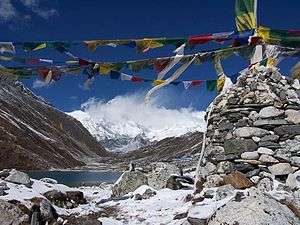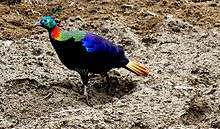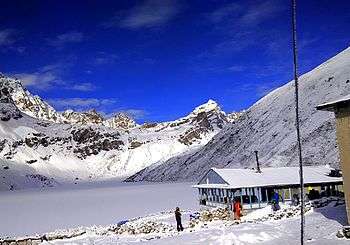Khumbu
Khumbu (also known as the Everest Region) is a sub-region in Solu Khumbu on the Nepalese side of Mount Everest.
- See Everest Base Camp Trek for the Nepalese trek to the foot of Mt Everest, and Qomolangma for the Tibetan side of Mount Everest.

Understand
The Everest region is officially called Khumbu and includes the Sagarmatha National Park (above Monju) and the Sagarmatha National Park Buffer Zone (between Lukla and Monju). The former is listed as an UNESCO World Heritage site.
Villages
There are many villages scattered throughout Khumbu. Below is a list of nine of the most important to travellers. Others can be found on the Walk section of the Everest Base Camp Trek article.
- Ghat - located between Lukla and Monju - small family temple and beautiful Mani stones and stupa
- 🌍 Khumjung - good place to take an acclimatization walk when staying in Namche - sacred cave
- 🌍 Khunde - near Khumjung - location of Khumbu's main Western medicine clinic
- 🌍 Lukla - location of airport - other than for taking a flight, no compelling reason to remain here
- 🌍 Monju - good place to stop on first night after arriving at Lukla
- 🌍 Namche Bazaar - the unofficial Sherpa capital - restaurants, cafes, museums, Tibetan medical clinic
- 🌍 Pangboche - picturesque village - small monastery
- Phortse - very traditional village on mountain opposite Tengboche
- 🌍 Tengboche - large monastery
- 🌍 Chhukhung - support village for the trekking to Island Peak or day trip to Chhukhung Ri
- 🌍 Dingboche
Other destinations
- Everest Base Camp Trek
- Island Peak Trek
- Cho La
- Gokyo Valley
Understand
|
Guru Rinpoche It is not possible to travel far in Khumbu without seeing images of a man wearing a tall elaborate hat and with eyes that are open wide and staring forward into space. This is the great 8th century sage of Vajrayana Buddhism, Padmasambhava or Guru Rinpoche as he often called. According to legend, Padmasambhava was reincarnated into a lotus blossom as an eight year old child, and from very young he possessed great wisdom and insight. He also had mastery of the elements and so like a potter shaping clay into pots, he transformed harmful action and substances into something positive and beneficial. Guru Rinpoche is credited with introducing Tantric Buddhism into Tibet and is specifically associated with the Nyingma tradition, the form of Buddhism that the Sherpas brought with them when they migrated over the Himalayas into Nepal in 16th century. Sacred sites associated with Guru Rinpoche in the Sagarmatha region are the Maratika Cave in Haleshi and a cave above Khumjung in Khumbu. |
Famous for its spectacular mountain peaks and the loyalty and friendliness of its inhabitants (the Sherpas), the Everest region (Khumbu) is one of the most popular destinations for tourists in Nepal. While many of the routes through the mountains are arduous, there are ample places to rest and enjoy a meal along the way. Don't worry about getting lost: just ask a local the way to the next village on your route, and they will direct you. Most Sherpas under the age of fifty can at least understand basic English, and many speak it fluently.
While trekking is possible in this area the whole year round, the best times to visit are from the beginning of March to mid May and from the beginning of September to end of November. The winters are very cold and snow may make it difficult to travel higher than Tengboche, and also lodges may be closed above this altitude. Summers, on the other hand, are wet, and the spectacular peaks often lost in the clouds. April and early May is a good time to see the hedgerows and trees bursting into bloom, with Rhododendrons, in particular, adding a spectacular splash of colour to the landscape. However, dust from the plains of India during the spring routinely provide less than ideal conditions for clear mountain views. The views are much better after the summer monsoons have cleared the atmosphere of dust, but the days are shorter and cooler.
TIMS (Trekking Information Management System) permits are required to venture forth for any trek, also for the Khumbu region, they are easy to obtain in Kathmandu at Nepal Tourism Board against US$20, a recent passport size photo and filling in the required form before you embark to your trek. If you are with an organised trekking party your tour operator will do this for you.
Also a National Park Entry Fee is required and can be obtained either in Kathmandu or while entering the Park.
Lodges and restaurants in Khumbu only accept Nepalese rupees. Budget can vary hugely between Rs 1,500-2,000 per person per day for food and accommodation - prices rise with the altitude, though you may spend more in Namche because there is more on offer. Add more if you consume beer, softdrinks and other amenities.
See Sagarmatha Park official website.
Talk
Sherpas speak their own language called Sherpa, which is related to Tibetan. Most Sherpas under the age of fifty can also speak English and Nepali. In addition, because many Sherpas have travelled overseas to work, it is not uncommon to meet Sherpas who are fluent in German, French and Japanese.
Get in
By plane
There are numerous flights flying the Kathmandu - Lukla route, though with a much reduced service during the off-season months. Sita is considered to be one of the more reliable airlines flying this route and operates two flights every morning from Kathmandu Domestic Airport at 07:00 and 08:20, with return flights at 07:40 and 09:00. Flights from Kathmandu take around 25 minutes. Be aware that during the summer rainy season there may be substantial delays, and even a wait of one week is not uncommon.
On foot
There is a bus running between Kathmandu and Jiri. Some buses are going a bit further to Shivalaya. From here to Namche Bazaar it is about a six-day walk. A less popular alternative is to walk from Tumlingtar.
Another route tried entering from Jaynagar, India, by train or bus. From Jaynagar its about 1-1½ day by bus or jeep to Phaplu via Madar, Sirha, Mirchaya Ramnagar, Katari, Okhaldunga and Salleri. Phaplu to Ringmo and 5 days trek to Namche.
Just after the village of Monju, there is check point for entering the Sagarmatha National Park. Passports need to be shown and there is a 1,000 Rs entry fee. At Monju two fees. For SAARC country TIMS fees rs 650 and for Sagarmatha National Park Rs 1695 with VAT for four weeks.
Get around
On foot. There are no roads in the Khumbu region. And sometimes by horse.
- Renjo La is a pass between Gokyo and Lungden with an elevation of 5,360 m and excellent views of Everest, Nuptse, Lhotse, Makalu, etc.
See
As a Zen poet once wrote: "Going deeper and deeper - still the green mountains". This could certainly have been written in Khumbu, but while the mountains are the obvious attraction, the area does offer many other sights.
Fauna


The national bird, danfe (a kind of pheasant), white-winged gros beak, Horn lark, Robin Accentor, Tibetan Snow Cock, red-billed chugh, yellow-billed chugh and mountain goats are common in the Khumbu area, and because the Sherpas do not kill animals or birds, people can often get very close before they take off. Musk deer and snow leopards are also natives of the Khumbu mountains, albeit rarer.
Do
Trek, eat, enjoy Sherpa hospitality and relish your time in such a beautiful and pristine environment.
Buy
Outside Namche, there are few souvenir shops and the handicrafts sold are similar to those on offer in Kathmandu. However, as the majority of goods are carried over from Tibet, which is much nearer to Khumbu than Kathmandu, you might find a few bargains and some unique items. Also, check out the clothing made from yak wool. This is often made locally, and so the prices may be lower than in Kathmandu. As in most parts of south-east Asia, remember to haggle for the best deal.
Eat
Most lodges offer similar menus - porridge, hash browns, omelettes, dal bhat, spaghetti, fried rice, apple pie, etc. - although those in Namche tend to have a wider selection, which includes such things as pizza and juice.
Bakeries, which began as a Namche phenomena, now also operate in Khumjung and Tengboche, offer such luxuries as freshly baked pizza, German breads, pastries and even cappuccino - or as one lodge in Monju advertised: Sherpaccino!
Local dishes include:
Riki-Kur - the Sherpa dish of potato pancakes, which are delicious eaten straight off the griddle and covered with dzo (female yak) butter and a sauce made of mature cheese and spices called sorma. Due to the effort involved in making them, they are generally not listed on lodge menus. However, most places will oblige if you order well in advance.
Tzen - a heavy patte made from millet and flavored with spices.
Drink

Locally bottled water is available everywhere in Khumbu, though the price rises with the altitude. A bottle in Namche costs about 100rs. Beer and juice are flown from Kathmandu to Lukla and carried from there by porters; consequently the price is very high. Tea, instant coffee and a drink made from lemon concentrate are the cheapest beverages in the region, and are available in every lodge or tea shop for Rs 50 to 150 a cup. As there is no way to recycle plastic bottles in Khumbu (there are bins available on all walks for plastic and paper), you might consider bringing your own container and either purchasing boiled water or purifying spring water with iodine tablets.
Sleep
Accommodation is in an abundance in Khumbu, and ranges from the luxurious Everest View Hotel near Khumjung to the very comfortable lodges in Namche down to those offering very basic facilities. Generally, the higher the altitude, the simpler the accommodation.
Stay safe
Khumbu is a very safe region and violent crime is almost unheard of. However, owing to the number of people flowing through the area on treks, it is advisable to always keep your valuables in sight.
Altitude sickness affects even young and healthy people and is a genuine problem in Khumbu. If you feel dizzy, suffer palpitations or a severe headache, return immediately to lower altitude. Do not take altitude sickness lightly. It can and does kill.
Yaks may be photogenic, but they are aggressive and unpredictable. Always stand on the upper slope (i.e., above the path, away from the drop-off) to let yaks pass. Every Sherpa has a tale about Westerners who have stood on the lower side of a trail to let a herd of yaks pass and been killed after being pushed off.
Don't drink the water no matter how pristine it appears. Use iodine tablets as a purifier or purchase boiled water. Exceptions: Namche and Phortse have clean water supplies that the locals drink directly from the tap. However, this may not be a good idea for outsiders lacking immunity to local bacteria, but certainly it should be OK for brushing teeth.
There is an emergency rescue centre in Namgyal lodge in the village of Machermo in the Gokyo Valley manned by two volunteer doctors. Note: This is purely an emergency rescue centre, and the doctors will not treat common ailments.
Stay healthy
- Clinics are sparse in Khumbu. Should you require medical attention there are several options:
- Western medicine - Kunde Clinic, in Kunde Village (above Namche) has Western trained doctors and is a surprisingly well equipped facility - they even have a decompression chamber for those suffering with severe altitude sickness. On your return journey, you might like to donate any unused medicines to Kunde Clinic, though ensure that they are clearly labelled in English - even the most valuable medicine is useless if there are no instructions on how to use it.
- Tibetan medicine - the Healing Centre in Namche offers treatments using natural formulas. It is next to the Camp de Base hotel, but entered from the path in front of the library. This clinic provides free treatment for porters and other patients on low income. In order to continue this service, donations are greatly appreciated.
- Medical Stations. Along the trail, you will also see small medical stations. These stations generally have very rudimentary facilities and can only realistically offer treatment for very minor ailments, such as cuts and bruises and (non-altitude sickness related) headaches.
- Dental clinic. Namche also has a dental clinic, located on the right side slope of the village when looking up.
- Water. Only drink water that has been thoroughly boiled or otherwise purified. Do not drink water directly from streams.
Connect
There are no telephone lines or mailing addresses in the Everest region.
Namche has a post office, but there are mixed reports of letters reaching their destinations. Postage stamps are also available in local shops.
International phone calls can be made in Namche, however this is very expensive compared to Kathmandu. The cheapest place is the one-phone government telephone office, on the second floor of the nondescript wooden building behind Hotel Buddha, identified with an official yellow sign in Nepalese with a faded paper sign in English stuck on to it. Expect a lengthy queue on Saturdays (market day).
Namche also has several Internet cafes. Satellite access costs between Rs 20-25 per minute, so keep a sharp eye on the clock when online.
Respect
Religious
According to the customs of respect in Tibetan Buddhism (which most Sherpas adhere), always pass mani stones and other religious objects with your right side nearest to the object and circumambulate stupas and turn prayer wheels in a clockwise direction. Never sit on mani stones, stupas or religious objects.
Environmental
Due to the sheer number of trekkers passing through this valley, the ecological structure is under severe strain. Therefore, it is important for visitors to be as sensitive to their surroundings as possible. Obviously, wild life and forna should not be disturbed, but in addition, trekkers can help by not leaving any kind of non-biodegradable material in Khumbu, but instead take it back to Kathmandu for disposal. Boiled water can be purchased at all lodges, so bringing a personal container avoids the need to purchase bottled water - which anyway is very expensive. Wood for fires should be used sparingly, and not at all when possible. Also try to limit dependence on canned foods, but instead order meals made from local produce, such as rikikul (potato pancakes) and dishes made of yak cheese.
Take only photographs, leave only footprints should be the mantra of every trekker in the Khumbu area. See article Leave-no-trace camping.